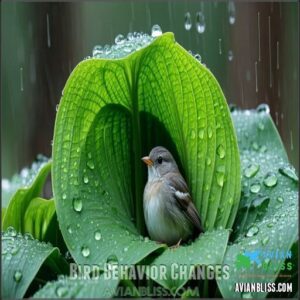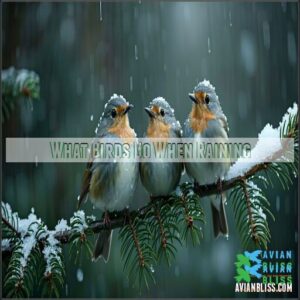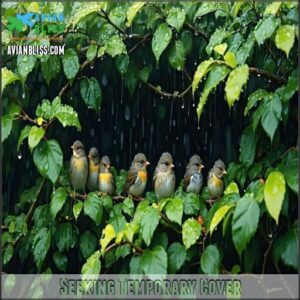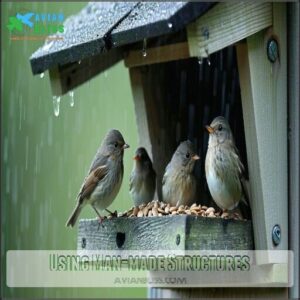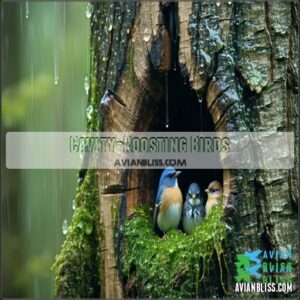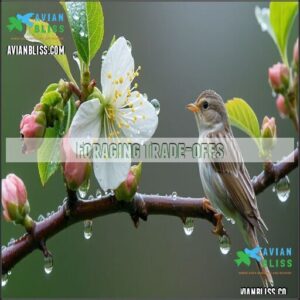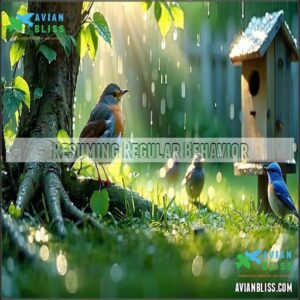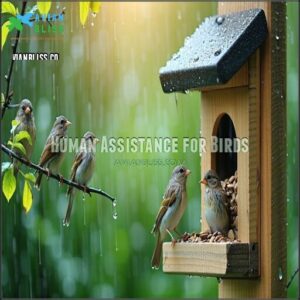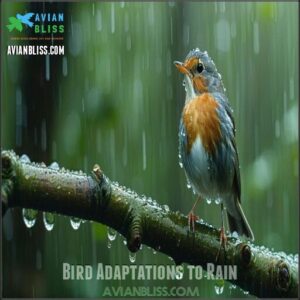This site is supported by our readers. We may earn a commission, at no cost to you, if you purchase through links.
 When it rains, birds aren’t just winging it—they’ve got strategies! Most birds seek shelter under dense trees, shrubs, or even eaves of buildings to stay dry and conserve energy.
When it rains, birds aren’t just winging it—they’ve got strategies! Most birds seek shelter under dense trees, shrubs, or even eaves of buildings to stay dry and conserve energy.
Their waterproof feathers, thanks to oil from preening, keep water off and insulation intact. Some birds fluff up to trap warm air, while others sit tight to prevent heat loss.
Certain species, like cavity-nesters, tuck themselves into tree holes for extra protection. Light rain might not bother them, and you’ll even see some bathing or snacking on worms.
Curious how rain shapes their daily routines? Stay tuned for more fascinating behavior insights!
Table Of Contents
- Key Takeaways
- Bird Behavior Changes
- What Birds Do When Raining
- Shelter Seeking Strategies
- Rain Impact on Birds
- Bird Adaptations to Rain
- Frequently Asked Questions (FAQs)
- What happens to birds when it rains?
- Do birds care if it rains?
- How do birds know if it’s raining?
- How do birds survive a rainy day?
- What do birds do during rainfall?
- How do birds cope with rain?
- Are birds bothered by rain?
- How do birds deal with heavy rain?
- Where do the birds go when it’s raining?
- What do birds do at night when it rains?
- Conclusion
Key Takeaways
- Birds seek shelter under trees, shrubs, porches, or cavities to stay dry and conserve energy.
- Feather waterproofing from preening oil helps birds repel water and maintain body heat.
- They huddle together or fluff their feathers for warmth during cold or heavy rain to avoid hypothermia.
- Foraging slows during storms, but birds quickly resume feeding and activity after the rain stops.
Bird Behavior Changes
You’ll notice birds dramatically change their behavior when rain clouds gather, shifting from active flying and foraging to energy-conserving postures with flattened feathers and tucked heads.
Depending on the rain’s intensity, they’ll either continue carefully searching for food or seek shelter under dense foliage, with smaller species hiding longer due to their higher risk of hypothermia.
Conserving Energy
During rainstorms, you’ll notice birds adopting an upright posture with beaks pointed upward, minimizing contact with raindrops.
This perching strategy isn’t just about staying dry—it’s a vital energy conservation technique. Birds reduce movement and huddle together, creating collective warmth through feather insulation.
Understanding weather’s impact on bird behavior is key to appreciating these adaptations.
By remaining still, they preserve precious energy reserves that would otherwise be depleted in wet conditions. These avian survival mechanisms help birds weather storms without exhausting their limited resources.
Avoiding Hypothermia
During rainfall, birds face a serious threat of hypothermia when their feathers become saturated.
I’ll create a short, engaging blockquote about birds facing hypothermia when their feathers get saturated during rainfall:
Saturated feathers spell danger for birds—a race against time as hypothermia threatens their delicate bodies.
You’ll notice they fluff their feathers to maximize insulation and trap warm air close to their bodies.
When completely soaked, small birds lose heat rapidly due to their high surface-to-volume ratio.
Many species employ huddling behavior to conserve energy and maintain body temperature.
Their sophisticated thermal regulation system works remarkably well unless they’re exposed to prolonged downpours.
Seeking Shelter
You’ll notice birds don’t just vanish during downpours – they’re actively seeking shelter!
Birds instinctively head for natural shelters like dense trees and shrubs, while urban birds utilize buildings, awnings, and bridges.
They’ll often group together, huddling for warmth and protection from predators.
Shelter duration varies by species and rain intensity, with most birds emerging within minutes after light rain stops, maintaining a balance between survival and shelter that keeps birds relatively safe during wet weather.
What Birds Do When Raining
Birds show remarkable resilience when it rains! Many species adjust their behavior to survive wet weather with clever strategies.
- Foraging continues: Some birds brave the wet, searching for food when the rain isn’t too heavy.
- Huddling up: Storm grouping provides warmth and reduces rain exposure, a savvy survival move.
- Feather management: Their natural insulation keeps them warm, though heavy rain makes fluffing difficult.
Despite challenges, birds in rain showcase incredible adaptability and will often resume post-rain activity once skies clear. To maintain their body heat, many birds will use waterproof feather adaptations.
Shelter Seeking Strategies
You’ll find birds using remarkably diverse strategies to stay dry during rainstorms, from huddling under dense foliage to taking shelter in tree cavities and human structures.
While small songbirds might squeeze into shrubs or brush piles, larger species often simply hunker down, flattening their feathers to enhance water resistance and conserve precious body heat, utilizing a strategy that involves complete concepts like these to survive.
Seeking Temporary Cover
When raindrops start falling, you’ll notice our feathered friends quickly seeking temporary cover.
Natural canopies like dense thickets and hedgerow havens become prime real estate for rainy day birds.
Look closely at evergreen trees where birds tuck themselves against trunks, using branches as umbrellas. Small songbirds often hunker down in shrubs, while larger species might wait out showers under thick foliage, keeping their feathers dry and reducing hypothermia risk.
Using Man-made Structures
During rainstorms, you’ll find birds taking refuge in and around human structures.
They’ll huddle under porch overhangs, nestle into barn rafters, or slip into open sheds for protection.
Bird shelters like roosting boxes provide excellent sanctuary when properly placed away from prevailing winds.
Consider buying bird roosts to provide additional shelter.
Strategic feeder placement near buildings offers birds a chance to grab food while staying relatively dry.
Bat houses can inadvertently serve as temporary rain shelters too, providing an alternative form of sanctuary.
Cavity-Roosting Birds
While some birds brave the elements in human structures, cavity nesters have perfected the art of staying dry.
These clever birds duck into tree holes, snags, or nest boxes when raindrops start falling.
Woodpeckers, bluebirds, and chickadees rely on natural cavities for shelter, highlighting snag importance in forests.
During downpours, you’ll find them snug in their wooden sanctuaries, demonstrating roosting behavior that’s essential for winter survival too.
Branch-Roosting Birds
While cavity-nesters find shelter in enclosed spaces, not all birds have such luxurious accommodations during rainfall.
Branch-roosting species display remarkable adaptations when seeking protection among tree limbs.
You’ll notice these feathered friends employ several clever techniques when raindrops start falling:
- Choosing branches closest to tree trunks for maximum coverage
- Perching on the downwind side to minimize exposure
- Adopting upright postures with beaks pointed upward
- Flattening feathers for enhanced water resistance
- Huddling together for warmth and shared protection
During migration, some species also utilize tree branches as roosting to find shelter and protection among the trees, using their adaptations to survive the rainfall.
Rain Impact on Birds
You’ll notice that rain impacts birds far beyond just getting their feathers wet, affecting everything from food accessibility to energy conservation.
When raindrops fall, birds must balance the urgent need to stay dry and warm against their constant requirement for food, creating a survival challenge that shapes their behavior during storms, which is crucial for energy conservation.
Food Accessibility
While birds find comfortable hiding spots during rainfall, their access to food becomes substantially limited.
After sheltering for a while, hunger eventually drives them to brave the elements.
| Rain Intensity | Food Accessibility | Bird Feeding Strategy |
|---|---|---|
| Light Drizzle | Moderate | Regular foraging continues |
| Steady Rain | Limited | Quick feeding trips between shelter |
| Downpour | Very Poor | Wait it out in shelter |
| Thunderstorm | Dangerous | Complete feeding pause |
| Post-Storm | Excellent | Increased foraging activity |
You’ll notice heightened bird feeding in rain immediately before storms and right after they pass, which is a result of the substantial limitation of food access during heavy rainfall, leading birds to engage in quick feeding trips or wait for the post-storm period when food accessibility becomes excellent again, allowing for increased foraging activity.
Foraging Trade-offs
When the heavens open up, birds face critical foraging trade-offs that directly impact their survival.
During rainfall, they must balance energy expenditure against the risk of getting soaked or attacked by predators.
- Food availability dramatically decreases as insects seek shelter and seeds become waterlogged
- Weather impact extends beyond just getting wet—humidity affects flying efficiency
- Foraging duration shortens to minimize exposure to rain
- Birds in rain typically eat more quickly and choose closer food sources
Resuming Regular Behavior
After the downpour ends, you’ll notice birds quickly return to their normal routines.
After rain, birds swiftly resume foraging, feather preening, and social bonding, showcasing resilience and adaptability to refreshed post-storm conditions.
While foraging becomes the priority, birds follow distinct patterns when resuming their regular behavior.
The birds’ activities can be summarized in the following table:
| Post-Storm Activity | Timing | Purpose | Energy Level | Priority Ranking |
|---|---|---|---|---|
| Feather drying | Immediate | Prevent hypothermia | Low | 1 |
| Bird preening | 5-10 minutes | Feather maintenance | Medium | 2 |
| Post-storm foraging | 10-30 minutes | Replenish energy | High | 3 |
| Social interaction | Variable | Community bonds | Medium | 4 |
| Territory re-establishment | Within hours | Defend resources | High | 5 |
The priority of these activities is crucial for the birds’ survival, with feather drying being the most immediate concern to prevent hypothermia.
Improved Flying Conditions
After the rain stops, birds experience improved flying conditions due to higher air density.
You’ll notice they take advantage of reduced turbulence and changes in air pressure to generate better aerodynamic lift. Their wing saturation decreases as feathers dry, making flight more efficient.
Birds often utilize post-rain wind currents for soaring techniques with minimal energy expenditure. It’s nature’s way of compensating them for waiting out the storm, providing an opportunity for efficient flight!
Human Assistance for Birds
Providing sheltered feeders during rain gives birds a dry place to refuel.
You can protect your bird feeders by moving them under trees or adding roof extensions.
Roosting pouches offer immediate shelter for small birds in your garden.
Creating brush piles, rock piles, and planting native shrubs provides natural refuge during storms.
These simple steps help birds conserve energy and avoid hypothermia when skies turn gray.
Birds often seek refuge in dense evergreen canopies during downpours.
Bird Adaptations to Rain
You’ll be amazed at how birds have evolved remarkable physical adaptations that help them weather even the heaviest downpours.
Their specialized feather structure and natural oils create a waterproof shield that lets raindrops roll right off while trapping warm air close to their bodies.
Feather Maintenance
Once birds find shelter from the rain, they don’t just sit idle.
You’ll notice birds spending significant time preening their feathers, a critical maintenance ritual. They use their beaks to realign feather barbs and spread oil from special oil glands near their tails.
This thorough grooming keeps their feather structure intact, ensuring proper insulation properties during wet weather.
Birds require specialized preening products for ideal feather care. Without regular preening, birds would lose their natural protection against rain.
Water Resistance
Ever wondered how birds stay dry during a downpour? Their feathers aren’t just naturally waterproof—they’re engineering marvels of water resistance. This natural protection helps prevent hypothermia when rain strikes.
Birds’ waterproof feathers work through:
- Specialized barbules that interlock like tiny zippers
- Microscopic structures that create water-repellent surfaces
- Air pockets between feathers providing insulation properties
Without this water resistance, birds would quickly become waterlogged and dangerously cold. Some owners use specialized feather sprays to maintain this, ensuring their birds stay dry and dangerously cold is avoided.
Preening and Oiling
Every bird possesses a special oil gland at the base of its tail that’s key to feather waterproofing.
When you spot birds preening, they’re not just primping—they’re applying this natural water resistance to their feathers.
By spreading oil across their plumage using their beaks, birds maintain a waterproof barrier that helps raindrops roll off instead of soaking in, keeping them relatively dry during showers, which is crucial for their overall water resistance.
Fluffing and Flatting Feathers
Have you ever noticed birds looking puffier in light rain? They’re actually fluffing their feathers to create air pockets for insulation against the cold.
When downpours intensify, they’ll flatten these same feathers, creating a natural raincoat for maximum water repellency.
This remarkable adaptation helps prevent hypothermia risk by directing raindrops to slide off rather than penetrate to their skin. Birds alternate between these rain postures as conditions change.
Rain Bathing and Cleaning
While birds flatten their feathers in heavy rain for protection, you’ll often spot them intentionally bathing during light showers.
They clean themselves twice daily, and rain provides a perfect opportunity. They’ll perch on exposed branches, wings and tails spread wide to catch droplets.
After their rain bath, they’ll shake vigorously to remove excess water, followed by thorough preening and sun drying to restore their feathers’ natural luster.
Frequently Asked Questions (FAQs)
What happens to birds when it rains?
Did you know small birds can lose heat twice as fast as larger ones in rain?
They hunker under leaves, fluff feathers for warmth, and avoid flying to conserve energy, braving wet weather cautiously!
Do birds care if it rains?
Sure, birds notice the rain, but they don’t mind small showers much.
Heavy rain? That’s different—they’ll tuck under branches or bushes to stay dry, conserving energy, because wet feathers can lead to hypothermia.
How do birds know if it’s raining?
Funny enough, birds don’t rely on weather apps—they sense rain through drops in air pressure, changes in humidity, and sound vibrations.
Their instincts tune them in, like their own natural weather radar.
How do birds survive a rainy day?
Birds survive rainy days by seeking shelter under branches, shrubs, or porches.
They fluff feathers in light rain for warmth, flatten them in heavy rain, and huddle together to conserve heat, avoiding hypothermia risks.
What do birds do during rainfall?
Imagine rain as nature’s intermission—birds hunker down like actors waiting backstage.
Small ones shelter under branches, big ones perch still, and some, like ducks, relish it.
Feathers repel water, but storms demand energy conservation.
How do birds cope with rain?
When it rains, birds hunker down under branches, shrubs, or roofs, fluffing or flattening feathers to shed water.
They conserve energy by perching still, avoiding flight, and quickly forage between downpours to stay energized.
They also conserve energy by these actions, which is crucial for their survival.
Are birds bothered by rain?
Rain doesn’t exactly ruin a bird’s day, but it’s no spa treatment either.
Birds hunker down, fluff feathers, or shelter under trees.
Wet feathers risk hypothermia, so they conserve energy and forage when necessary.
How do birds deal with heavy rain?
In heavy rain, birds hunker down, sheltering under branches, shrubs, or human structures.
They conserve energy by perching and fluffing feathers for warmth or flattening them, letting water slide off, minimizing movement until storms pass.
Where do the birds go when it’s raining?
Birds hide in shrubs, trees, or cavities to stay dry.
Small birds tuck into dense bushes, large ones perch still, and some use porches or sheds.
They’ll huddle downwind, conserving energy and waiting it out.
What do birds do at night when it rains?
Feathered friends find foliage for shelter, fluffing feathers or crouching in cozy corners like tree trunks or dense shrubs.
They’ll huddle silently, conserving warmth and energy, waiting out drizzles or downpours under nature’s leafy umbrellas.
Conclusion
Did you know some birds can lose up to 10% of their body weight foraging in the rain?
When it rains, birds don’t just endure—they adapt. From preened waterproof feathers to creative shelter strategies, they manage to stay warm, dry, and nourished.
Whether they’re huddled under a tree, perched in a cavity, or catching a quick snack, their responses showcase nature’s ingenuity and fascinating behaviors.
Next time it rains, take a moment to look for these fascinating behaviors!

